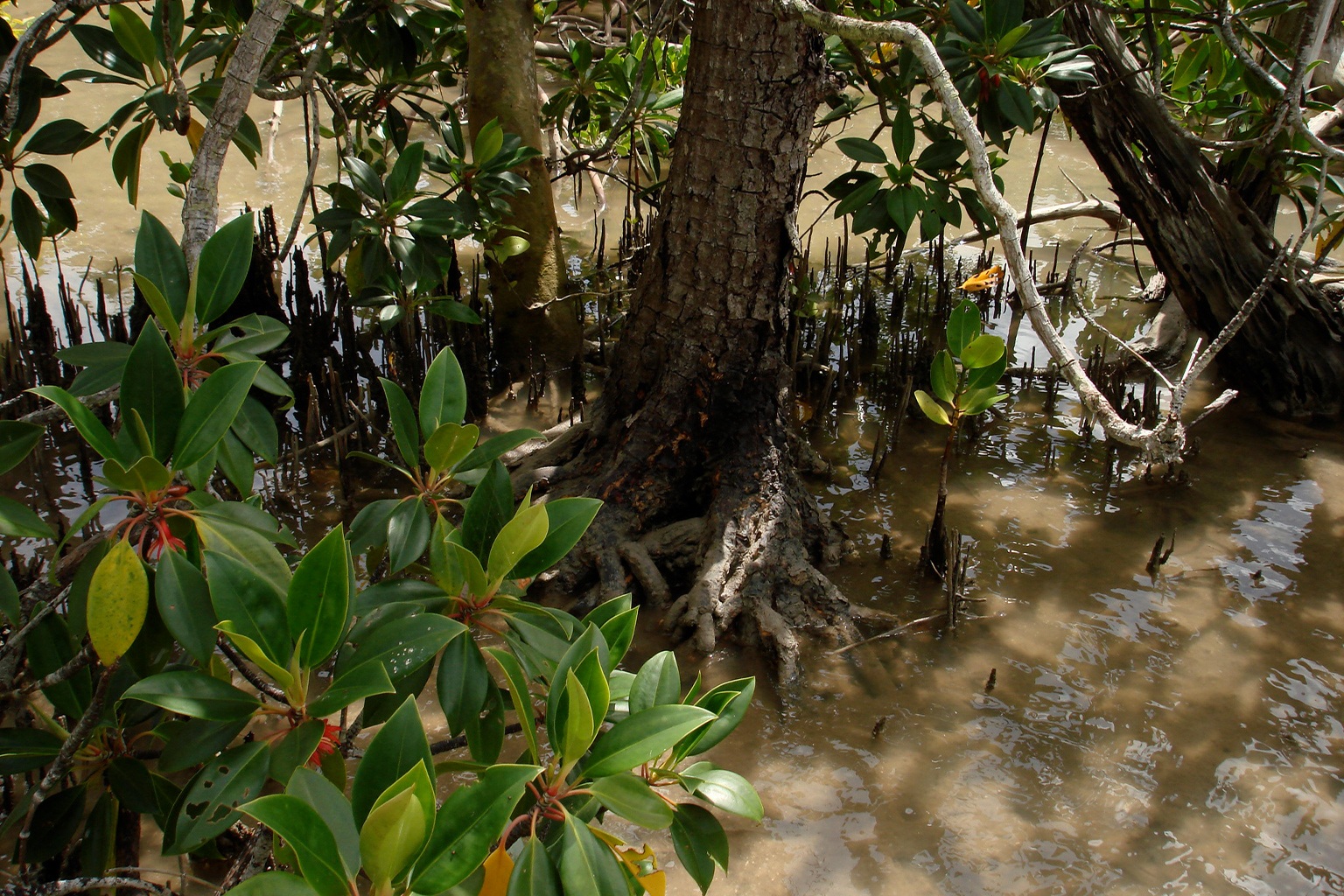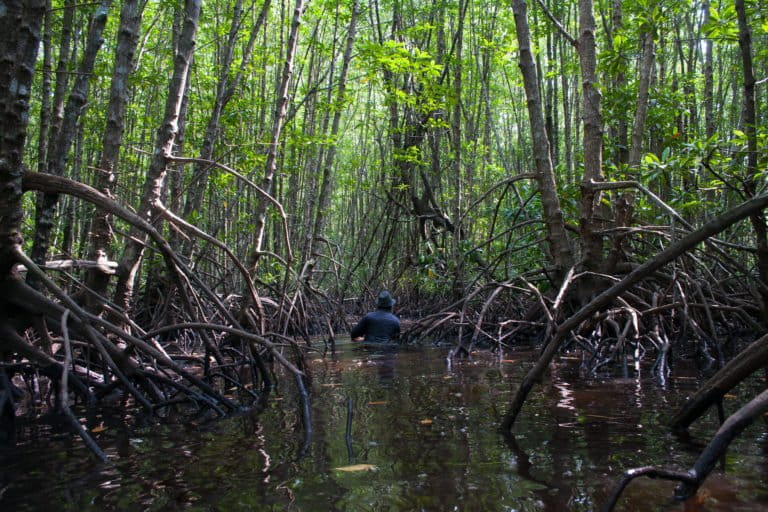- Mangroves’ high carbon storage capacity can help countries meet their carbon emission reduction targets under the Paris Agreement, while also producing benefits for local communities.
- Recent research using data from Belize has quantified mangrove carbon storage and sequestration potential and identified where the country should prioritize conservation and restoration to maximize ecosystem services that would benefit multiple sectors.
- The research has been used by Belizean authorities to update national climate targets, committing to protect an extra 12,000 hectares (30,000 acres) of mangroves and restore another 4,000 hectares (10,000 acres) by 2030, which could provide an example for other national blue carbon strategies.
- The study also took into account the point where mangrove protection and restoration begin to offer diminishing returns, which would allow authorities to adjust the ambition of climate mitigation and adaptation via mangroves.
Mangroves’ capacity to store carbon — up to five times more than upland tropical forests — makes them a powerful natural solution for reducing greenhouse gas emissions and tackling climate change. But according to a recent study that argues carbon storage and sequestration via mangroves can be both a climate solution and an economic boon, few countries have accounted for this type of nature-based solution when making their emissions reduction pledges, or nationally determined contributions (NDCs), to the Paris climate agreement.
The study, published in Nature Ecology & Evolution, focused on Belize and quantified how much carbon its mangroves capture and store, while also looking where mangrove conservation needs to be prioritized so that both climate and local economic goals can be met.
Belize is renowned for its marine resource management and conservation. The Natural Capital Project, based at the Stanford Woods Institute for the Environment, which conducted the new research, has been collaborating with WWF Belize and the Belize government since 2010, helping the country use a science-driven approach to incorporate the benefits of different ecosystems into its sustainable development planning.
“In 2020, we identified the opportunity to inform the Belize revised national contributions under the Paris climate change agreement through our partnership,” said study co-author Jade Delevaux, a life science researcher with the marine team at the Natural Capital Project. “With support from The Pew Charitable Trusts and WWF, Belize formed the National Blue Carbon Working Group to help guide updates to Belize’s NDCs to include evidence-based targets for restoration or protection of mangroves and seagrasses.”

To assess how much carbon mangroves absorb and stock (storage), the research team made vegetation measurements and collected sediment core samples.
“Vegetation measurements are used to estimate how much carbon is stored as biomass. The rate of carbon sequestration is calculated based on the carbon sediment stocks and the age of the sediment measured from the core samples. Rigorous measurements need to reflect those changes,” Delevaux told Mongabay.
Using mangrove distribution maps, the experts then determined where protection or restoration needed to happen according to the level of degradation.
“The flow of co-benefits provided by mangroves vary spatially and thus can influence where to prioritize mangrove protection and restoration,” Delevaux said. “Our analysis identified patches of mangroves or areas where restoring mangroves can help bolster local benefits to Belizean communities, while promoting blue carbon sequestration to meet Belize’s climate goals.”
Results showed that the most important places for investing in mangrove protection were outside existing marine protected areas. But the study also points out there can be a limit to conservation, after which the benefits begin to diminish. Understanding that inflection point could help authorities adjust just how ambitious their conservation and restoration plans need to be.
The study has supported Belizean policymakers in updating the country’s NDCs toward meeting the Paris Agreement goals. Under the revised plans, around 12,000 hectares (30,000 acres) of healthy mangroves will become protected by 2030, on top of the current 13,000 hectares (32,000 acres). The new commitments also include 4,000 hectares (10,000 acres) of degraded mangroves selected for restoration. It’s expected that these areas will help preserve up to 7.7 million metric tons of carbon.

In addition, the study says, this would foster continued visitation of at least 3,000 tourists to mangrove destinations every year and safeguard 300,000 pounds (136,000 kilograms) of spiny lobster catch worth B$2.5 million ($1.24 million) annually — an amount equivalent to more than 5% of the country’s entire seafood export, valued at $21.3 million in 2019, the year when the values used in the study were calculated. Also, the increased protection provided by mangroves would halve the number of people considered at highest risk from coastal hazards by 2030.
Calculations could help other regions
“Our study serves as an example for the more than 150 other countries that have the opportunity to enhance greenhouse gas sequestration and climate adaptation by incorporating blue carbon strategies that provide multiple societal benefits into their NDCs,” Delevaux said.
Researchers not involved with the work who analyzed the paper at Mongabay’s request agree.
“The biggest contribution of this study is to measure and evaluate the co-benefits of mangrove protection to the economy, considering tourism and fishing,” said Hermano Melo Queiroz, an agronomic engineer at the University of São Paulo in Brazil. “In other words, the approach aligned science with social and economic development, proving to be a real ‘nature-based solution.’”
Queiroz emphasized the importance of mangrove carbon sequestration and the need to protect this kind of environment. Using the most recent data available, he estimated that the destruction of just 1.9% of mangroves globally would release about 240 million metric tons of carbon dioxide — equivalent to the annual emissions of 63 coal-fired power plants or 51 million cars. There’s another problem that arises from the loss of mangroves: while they sequester and store CO2 in their underwater roots, they also produce methane. Normally, this gas is almost entirely consumed by microorganisms.

“But when these ecosystems are degraded, not only do they stop sequestering carbon: they also release a ‘bomb’ of CO2 and methane,” Queiroz said.
Marcus Fernandes, a researcher at the Mangroves Ecology Lab at the Federal University of Pará, in the Brazilian Amazon, also said the Belizean example could serve other nations.
“When you look at the Brazilian mangroves, that same approach could be applied here, because we still have a lot of areas to recover and at the same time big areas to preserve,” he said. Brazil has some of the world’s largest share of mangroves, at 9% of the global total, second only to Indonesia.
A June report by the Global Mangrove Alliance shows that the world has lost nearly 1.2 million hectares (3 million acres) of mangroves since 1996. The rate of loss has slowed down in recent years, and is currently at around 0.04% annually. According to Fernandes, there are many ways to ensure it doesn’t pick back up.
“Following the environmental laws where they exist is already an effective and relevant action to reduce the degradation of many mangrove areas, avoiding developments with harmful activities and the use of resources in a predatory way,” he said.
According to Delevaux, the software used in her team’s study is open access, which should make it easier for other countries to achieve similar assessments of their resources.
“This approach can be replicated by leaders and decision-makers in other countries interested in balancing economic and ecological benefits of mangroves and wetlands,” she said.
But to ensure governments and communities are able to maximize tourism, fisheries and coastal risk reduction as well as blue carbon benefits, there needs to be a concerted effort, she said — like the one seen in Belize.
“The application of these tools is more powerful when embedded in an existing policy or finance mechanism decision-making process and applied by a transdisciplinary partnership,” Delevaux said.
Citation:
Arkema, K. K., Delevaux, J. M. S., Silver, J. M., Winder, S. G., Schile-Beers, L. M., Bood, N., … Young, A. (2023). Evidence-based target setting informs blue carbon strategies for nationally determined contributions. Nature Ecology & Evolution, 7(7), 1045-1059. doi:10.1038/s41559-023-02081-1
Banner image: Mangroves on Glover’s Reef, Belize. Image by KimonBerlin via Flickr (CC BY-SA 2.0)
Related audio from Mongabay’s podcast: A discussion of mangroves as a natural climate solution with leading expert Alfredo Quarto, listen here:
Related reading:
Meet the ‘forest fishers’ restoring mangroves and livelihoods in Mexico
Indonesia’s ‘essential’ mangroves, seagrass and corals remain unprotected
